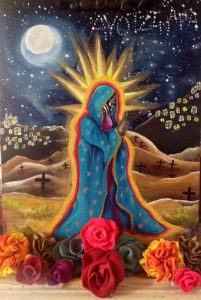San Diego artists create art for Ayotzinapa

A group of diverse and multigenerational San Diego artists is raising its voice through art as a tribute and to raise awareness about the dissapearance of 43 college students in Iguala, in the Mexican state of Guerrero.
The art exhibition, titled 43 in representation of the 43 students, will be a one-night show on Saturday, December 13th, from 5 p.m. to 10 p.m. at Original Gentleman Barbershop and Gallery at 2113 Logan Avenue in San Diego.
The exhibition features 43 works by 43 local artists “in honor and solidarity with Ayotzinapa,” the small town in Guerrero where the rural teachers’ college the students were enrolled is located.
“The message of all 43 artists is that countless miles away and without borders we are standing in solidarity with town of Ayotzinapa, all the students of Escuela Normal and the families of the 43 missing students,” said Elena Marques, one of the show’s organizers as well as one of the featured artists. “Our goal is to take this number, 43, from a statistic to a human tragedy with names and faces in hope of opening the eyes of our community to this horrendous human rights injustice.”
Marques said that each of the 43 artists, which include a wide array of voices in San Diego, was given a photo and a name of each student to represent, not necessarily in a portrait format, but in whatever way spoke to them.
“It is important to put a face and a personal story to each of these students because it humanizes the situation, to make it as real and as raw as it is, not only a statistic,” she said. “When these students with 43 names, families and stories become human not a number, it elicits anger, sadness, and a real message that something needs to be done about it regardless of the side of the border you are on. It creates a forum for discussion among artists and the community for a further plan for action in the face of such a blatant and large scale human rights violation.”
Marques said that the Ayotzinapa case, which has sparked a wide array of protests throughout Mexico and the world, is similar to the police brutality cases that have prompted protests in the United States.
“It is a universal human rights violation, one in the same with the injustices done to Eric Garner and Mike Brown,” said Marques, who is remembering 21-year-old student Everardo Rodriguez Bello with her painting, “The Universal Mother.” “It is a consequence of an abuse of power and an overly militarized police force. These students were not wealthy or privileged.”
One of San Diego’s most prominent Chicana artists and Chicano Park muralists, Carmen Kalo, said that the exhibition is part of the long history of activism present in the artistic community of Barrio Logan and other areas.
“This is a call to action and awarness that the behavior in Mexico and treatment of the poor will not be tolerated,” she said.
“This art exhibit is an educational format to bring awareness to the public. The border does not stop us from caring; we are Indigeneous seeds and these are our relations.”
Kalo added that the paintings are a reminder that artists from San Diego will not remain quiet in the face of injustice.
“We stand together in spirits and solidarity with the parents of the 43 students and all those who have been discrimated against in the name of corruption,” Kalo said. “We are here to let them know we will not forget their lives the 43 students are worth fighting for.”
Another artist, Adriana Galaz, said that people in San Diego, not only artists, should be aware of what is happening in Mexico.
“As artists I believe we have the responsibility to use our talents to create consciousness and empower others,” said Galaz, who is remembering student Carlos Lorenzo Hernandez Muñoz. “It matters because the United States, with its unsuccessful War on Drugs, is directly connected to the present day violence in Mexico.”
Mexican Consul General in San Diego, Remedios Gomez Arnau, said in an email that the Mexican government “always respects the free expression of ideas” be it through art or through peaceful protests.
But Marques said the Mexican government is much to blame for the violence in Mexico.
“There has been a significant amount of indifference and evasion of answers from the Mexican government surrounding this entire situation and in decades past of human rights violations, which has brought us all across multiple countries to stand and demand answers,” she said.
The art exhibition is San Diego artistic community’s response –and support—to Ayotzinapa.
“The outpour of support and participation from these artists as well as the community has helped to get our message straight to Ayotzinapa, that San Diego is standing at their side,” she said. “The response from us as artists demonstrates a strong, steadfast dedication to human rights.”






